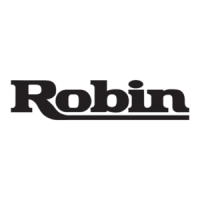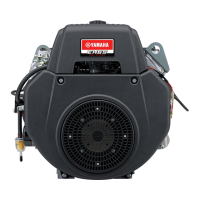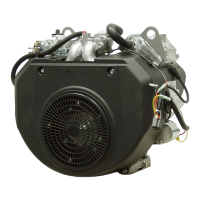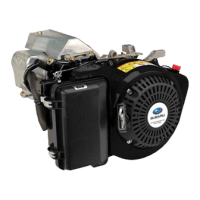
Do you have a question about the Robin America SP170 and is the answer not in the manual?
| Starting System | Recoil |
|---|---|
| Compression Ratio | 8.5:1 |
| Ignition System | Transistorized magneto |
| Fuel Type | Unleaded gasoline |
| Engine Type | Air-cooled, 4-stroke, single cylinder, OHV |
| Displacement | 169 cc |
| Oil Capacity | 0.6 liters |
| Dry Weight | 15.0 kg |
| Cooling System | Air |
Defines maximum engine output when throttle is fully open and parts are broken in.
Specifies sustained engine output for optimal life and fuel consumption.
Details the peak torque produced by the engine at a specific RPM.
Graphical representation of engine output and torque across RPM range for EX13D.
Highlights the engine's low noise level and soft tone quality.
Details features for reliable starting and absence of kick-back.
Focuses on high parts commonality and simplified maintenance procedures.
Covers reliability and durability through OHC system and bearing design.
Explains high power, low fuel consumption, and environmental compliance.
Describes the die-cast aluminum cylinder and crankcase construction.
Explains the function and design of the main bearing cover.
Details the material and construction of the crankshaft.
Describes the connecting rod and piston assembly materials and design.
Details the types and materials of piston rings used.
Describes the camshaft construction and integrated sprocket.
Explains the OHC and OHV valve construction.
Covers the cylinder head design and combustion chamber.
Explains the centrifugal flyweight type governor function.
Describes the forced air-cooling system and baffles.
Details the oil splashing lubrication method.
Explains the timing chain system for camshaft lubrication.
Describes the transistor controlled magneto ignition system.
Details the horizontal draft carburetor and its calibration.
Describes the quieter air cleaner and element types.
Explains the balancer for vibration reduction in Model EX27D.
Details the automatic decompression system for easier starting.
Illustrates the engine's cross-sectional view across the shaft.
Provides essential steps and warnings before starting disassembly.
Lists specialized tools required for disassembly and reassembly.
Step-by-step guide for safely disassembling engine components.
Provides critical guidelines and precautions for engine reassembly.
Detailed instructions for reassembling various engine parts.
Details API classifications for suitable engine oil grades.
Explains SAE viscosity grades based on ambient temperature.
Provides guidelines for engine oil inspection and change intervals.
Explains the T.I.C. type breakerless magneto ignition system.
Provides procedures for checking magneto defects and sparking.
Describes the T.I.C. (Transister, Igniter, Circuit) ignition system.
Explains the basic working principles of the ignition system.
Details the internal circuit of the ignition coil.
Presents the ignition timing characteristics graph.
Explains the basic working principles for the EX27 ignition system.
Illustrates wiring for models without an electric starter.
Shows wiring for models with electric starter (EX17, 21).
Illustrates wiring for the electric starter model EX27.
Depicts the wiring for the optional oil sensor system.
Lists voltage, power, and weight for starter models.
Explains the electrical circuits and engagement mechanism.
Diagrams showing the component parts of the electric starter system.
Details the type, resistance, and operating temperature.
Explains the construction and float-activated magnetic switch mechanism.
Explains how the system releases compression for easy starting.
Provides guidance for inspecting the release lever mechanism.
Lists specifications for main jets, pilot jets, and pilot screw turning.
Describes the float, pilot, main, and choke systems.
Step-by-step guide for disassembling and cleaning the carburetor.
Provides instructions for disassembling the recoil starter mechanism.
Details the steps for reassembling the recoil starter.
Describes checks for proper recoil starter function post-assembly.
Offers tips on spring handling and lubrication for recoil starters.
Emphasizes proper engine placement for accessibility and coupling.
Explains the importance of adequate fresh air for cooling and combustion.
Covers exhaust gas discharge and pipe diameter recommendations.
Details fuel tank height, pump use, and hose routing precautions.
Covers methods for transmitting power to drive machines.
Provides guidelines for proper V-belt drive installation.
Covers minimizing run-out and misalignment with flexible couplings.
Addresses issues preventing satisfactory engine start.
Covers problems related to poor output, overheating, and rough idling.
Addresses issues causing excessive engine oil consumption.
Details causes and remedies for increased fuel usage.
Covers sources and solutions for unusual engine noises.
Systematic checks for wiring continuity, battery, pinion, magnetic switch, and motor.
Provides standard part dimensions and wear limits for engine components.
Covers daily checks and cleaning for engine operation.
Details initial inspection and maintenance after 20 hours of use.
Outlines maintenance tasks required every 100 hours or 10 days.
Specifies maintenance for every 100 to 200 hours or monthly.
Details inspection and adjustment of valve clearance every 300 hours.
Covers cylinder head carbon removal and carburetor cleaning.
Outlines overhaul, piston ring, and fuel hose replacement.
Provides steps for preparing and storing the engine for extended periods.











